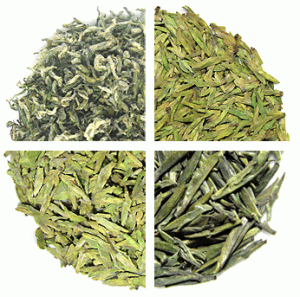Min Hong Gong fu teas are sweet, very stylish, slightly floral, slightly fruity, slightly malty, tippy black teas made in the eastern part of northern Fujian – north of the Min River, which is a geograpical divider between the teas from north and south Fujian.
These three teas are historic and important teas and are made in Fuan county, Fuding county and Zhenghe county, the same places where authentic Fujian white tea is made. In fact, some of these teas are made with the large leaf Da Bai cultivar that is used to make white tea, and also from a small leaf cultivar named Xiao Ye Zhong.
Min Hong teas were among the first black teas made in China, and Western tea drinkers would have known these teas (or a similar, earlier version) by the late 17th century. Other historic teas made in this area fell out of production in the 20th century, but these superb teas remain in manufacture today.
We are proud and excited to offer our tea enthusiast customers this special sampler of eastern China black teas that are not commonly seen in the US. All of these teas are of a high grade that contains a quantity of sweet tips – sip these black teas plain and you may find that no milk or sugar is needed.
The Tea Trekker Min Bei Sampler includes:
Bai Lin Gongfu

This slender, slightly twisted, tippy Fujian black tea is produced in the town of Hu Lin in Fuding County. Here, gongfu black teas are processed from the Fuding Da Bai cultivar, which is also used to produce the most famous bud-pluck white tea – Yin Zhen – which is made in some nearby villages.
This is a Chinese black tea for tea enthusiasts who enjoy the style of fruity Ceylon black teas. Bai Lin is light but distinctive and has a soft-flavor profile and underlying sweetness characteristic of many Chinese black teas.
Panyang Gongfu

Today, Panyang village primarily makes green tea. But fortunately for lovers of fine hong cha, a handful of tea companies still make Panyang gongfu.
This tea is among the finest manufactures of hong cha in China. Once made initially for export to the West, these fully-oxidized teas are much in demand among knowledgeable Asian/Chinese tea drinkers.
Fine and thin, the well-twisted & rolled budsets of this tea are gloriously perfect in size and form. The tea is comprised of a significant amount of dark-golden tip, more so than what is found in most Panyangs. This gives the tea a bright aroma of tea and caramel, the trademark aroma of Panyang hong cha.
In the cup, the aroma continually changes and shows incredible complexity. Hints of the aroma of grilled meat, to plum sauce, to chocolate cake with a rich pear buttercream frosting are just a few of the ideas proposed by those who have tasted this exquisite tea.
The flavor is complex, with a pleasant astringency. Both chocolate and cocoa are found here, with cocoa being predominant, followed by raisin and mild chile. The overall flavor is rich and mouth-filling and the body is deep and satisfying.
Zhenghe Gongfu

Thin, straight and wiry, this traditional pluck has a well-balanced proportion of golden tip to budset. The budset and tip are each of an even size and color and the aroma of the dry leaf suggests both biscuit and nut. This is a rich, fragrant but mild black tea with a brilliant golden-amber color in the cup.
The aroma and flavor are complimentary, both offering smooth, soft and round characteristics and a suggestion of wheat toast and caramel. The leaf has been carefully fired in the manufacture, and the liquor has a touch of ripe stone fruit in the taste.
NOTE:
What is gongfu tea?
We are often asked about the meaning of gong fu tea as many know this term to refer to a skillful style of Chinese presenting, steeping, and serving tea.
Yes, but the term gongfu alone means ‘skillful’. So, gongfu or gongfu cha is used to distinguish certain high-quality Chinese hong cha (black tea) that are made with discipline and skill and excellent crafting.
Gongfu black tea represents the Chinese approach to premium-quality tea making which values the taste of the tea; sweet, rich flavors in the cup; and a stylish appearance of the dried leaf. These qualities come from whole tea leaves that have been carefully crafted and fully oxidized.
These teas are not the same as China’s standard black teas that are exported in large quantities and often sold to companies who will add these teas to average quality proprietary blends. Such teas, for example, are sold simply as Fujian black or Hunan black tea without further place of origin attached.
So, gongfu does have two meanings and it can be a bit confusing. For instance, one can serve gongfu cha or congou tea gongfu-style and enjoy a skillful presentation of a skillfully made, delicious tea.








